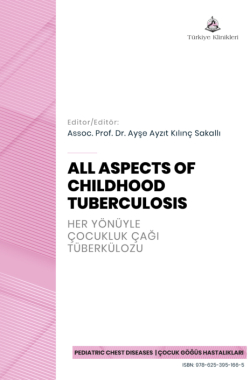Tuberculin Skin Test: Procedure and Interpretation
Abdulhamit ÇOLLAKa , Ali ÖZDEMİRb
aİstanbul University-Cerrahpaşa, Cerrahpaşa Faculty of Medicine, Department of Pediatric Chest Diseases, İstanbul, Türkiye
bUniversity of Health Sciences Mersin City Training and Research Hospital, Department of Pediatric Chest Diseases, Mersin, Türkiye
Çollak A, Özdemir A. Tuberculin skin test: Procedure and interpretation. In: Kılınç Sakallı AA, ed. All Aspects of Childhood Tuberculosis. 1st ed. Ankara: Türkiye Klinikleri; 2023. p.19-23.
ABSTRACT
Tuberculosis is still an important infectious disease in worldwide caused by Mycobacterium tuberculosis (M. tuberculosis). The bacillus commonly infects the lungs, and delayed diagnosis may have significant morbidity and mortality. M. tuberculosis culture is the gold standard for the diagnosis of tuberculosis disease. However, it takes time for bacterial growth and sputum culture cannot be achievable particularly in children. Therefore, additional tests require to confirm the diagnosis of the disease. The tuberculin skin test (TST) is a universal method for screening tuberculosis, but it does not completely diagnose the disease for various reasons. This test is based on a late hypersensitivity reaction to the tuberculin antigen. The test is not only positive in exposed individuals to M. tuberculosis but can be also positive in Bacillus-Calmette-Guérin (BCG) vaccinated humans and patients with nontuberculous mycobacterial infection. In addition, false negative results are major obstacle in immunocompromised individuals. Therefore, performing and interpretation of TST requires great attention and experience.
Keywords: Mycobacterium tuberculosis; tuberculin skin test
Kaynak Göster
Referanslar
- World Health Organization Global Tuberculosis Report 2022 [Internet]. @2022 [Access date: June 2, 2022] Available at: [Link]
- Kara F. T.C. Sağlık Bakanlığı Halk Sağlığı Genel Müdürlüğü Tüberküloz Dairesi Başkanlığı Tüberküloz Tanı ve Tedavi Rehberi. 2. Baskı. Ankara: Başak Matbaacılık; 2019. p. 17-8.
- Gençer B. Tüberkülinin Pürifiye Protein Derivesi [Purified Protein Derivative of Tuberculin]. Türk Hij Den Biyol Derg. 2001;58(1):27-32.
- Ursavaş A, Karadağ M, Sağlam DA, Yavuz Z, Yıldız F, Rodoplu E, et al. Tüberküloz tanısında tüberkülin deri testinin güvenilirliği ve bazı parametreler ile ilişkisi [The Reliability of Tuberculin Skin Test in Diagnosis of Tuberculosis and its Connection to the Some Parameters]. Uludağ Üniversitesi Tıp Fakültesi Dergisi. 2004;30(1):11-5.
- Lewinsohn DM, Leonard MK, LoBue PA, Cohn DL, Daley CL, Desmond E, et al. Official American Thoracic Society/Infectious Diseases Society of America/ Centers for Disease Control and Prevention Clinical Practice Guidelines: Diagnosis of Tuberculosis in Adults and Children. Clin Infect Dis. 2017;64(2):111-5. [Crossref]
- Holmberg PJ, Temesgen Z, Banerjee R. Tuberculosis in Children. Pediatr Rev. 2019;40(4):168-78. [Crossref] [PubMed]
- Say İ, Küçük B, Orak F, Aral M, Doğaner A. Latent Tüberküloz Enfeksiyonu Araştırılan Hastalarda QuantiFERON-TB GOLD Testi ile Tüberkülin Deri Testinin Karşılaştırılması [Comparison of QuantiFERON-TB GOLD Test and Tuberculin Skin Test in Patients Investigated for the Presence of Latent Tuberculosis Infection]. Türk Mikrobiyoloji Cemiyeti Dergisi. 2021;51(3):271-5. [Crossref]
- Çeliksoy MH. Tüberkülin Deri Testi [Tuberculin Skin Test]. Abant Tıp Dergisi. 2015;4(2):199-204. [Crossref]
- Unat DS, Erer OF. Latent Tüberküloz Enfeksiyonu Tanısı: Tüberkülin Deri Testi mi? İnterferon Gama Salınım Testi mi? Ortaköylü MG, Özlü T, editörler. ASYOD Güncel Göğüs Hastalıkları Kitap Serisi: Tüberküloz. Dünya Kitapevi; 2021. p. 37-7.

